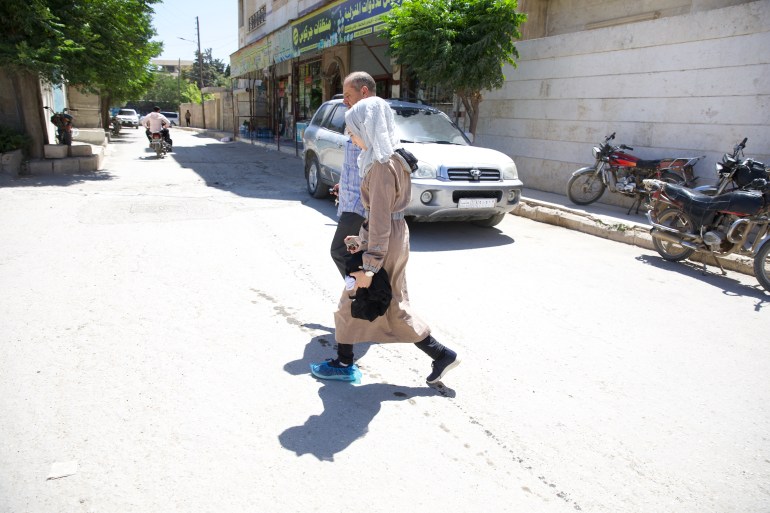Rima’s journey: Prosthetic gives Syrian new start after February earthquake
Rima Haj Hussein was trapped under the rubble and forced to choose between her life and her leg. Now she’s slowly rebuilding.
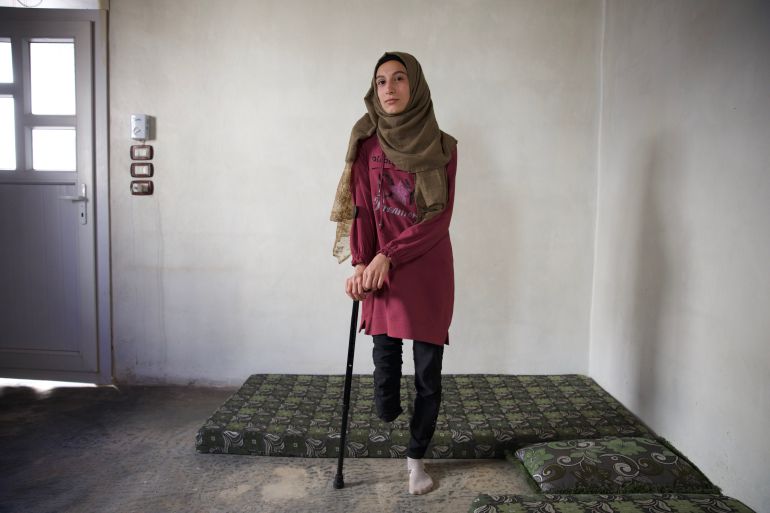
Azaz, Syria – With her smile as bright as ever, 15-year-old Rima Haj Hussein nervously walks into the Ataa Rehabilitation and Prosthetic Limb Centre for earthquake and war victims in Azaz, a town in northern Syria’s Aleppo governorate.
She recently celebrated passing her preparatory level exams, and her pride in pushing through after losing her leg in the massive earthquakes that hit southern Turkey and northern Syria six months ago is apparent.
Keep reading
list of 3 itemsSyrian government extends permission for limited UN aid to opposition areas
Six months on from earthquakes, tent hospital treats patients in Syria
“When the exam results were announced, I was especially happy that I fulfilled a part of my father’s wish for me. He always encouraged me to continue my education,” she said.
Rima had spent two months in a hospital near the Turkish border, asking her surviving family where her father was.
“I asked over and over why he didn’t come to visit me in the hospital, and they would dodge the question, saying his health condition prevented him from coming. Until I left the hospital and they told me … the shock of that moment will never leave me,” Rima said, having learned that her father had died in the earthquakes.
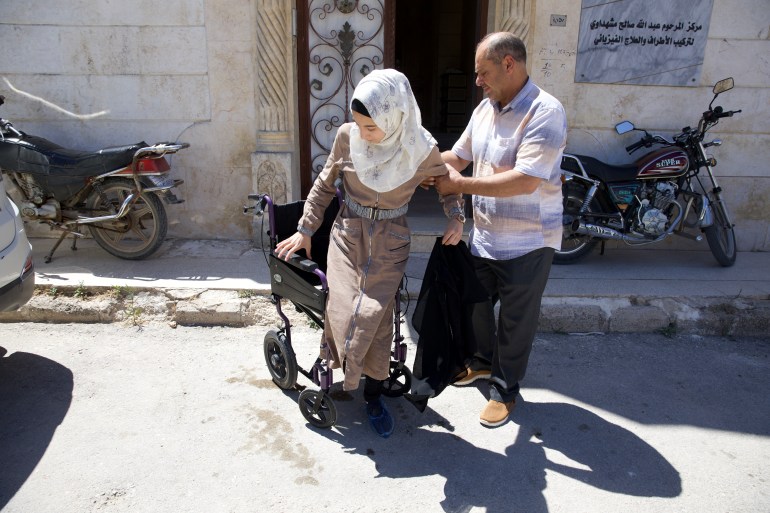
Fleeing into an earthquake zone
Rima and her family – originally from the city of Qalaat al-Madiq, northern Hama – had fled to opposition-controlled Jandaris in the Aleppo countryside in 2019 after Syrian government forces took control of their hometown.
A little more than three years later, Jandaris was the Syrian city most affected by the earthquakes, recording the highest Syrian death toll of 513 fatalities and 831 wounded, according to the Syria Civil Defence. More than 8,400 people died in Syria, with another 50,000 dying in Turkey.
When the earthquake affecting Rima hit in the early hours of February 6, she and her family were not able to open their apartment door in time and found themselves buried in the rubble when the building collapsed.
“After 30 hours of fear, buried under the rubble of our home, surrounded by neighbours who died, the rescue teams and my uncles managed to find a passage through the rubble and reached me,” she said.
Rima told Al Jazeera how the rescue teams and her uncles tried every possible way to extract her from under the rubble, but they were unable to due to her leg, which was trapped. Eventually, a medical team had to amputate her leg before she could be freed.
“I had two choices: either lose my life under the rubble or lose my leg. I chose to lose my leg,” Rima said.
After she was finally able to leave the hospital and still reeling from the news about her father’s death, Rima had to go back in for another surgery, this time to remove her gallbladder.
And yet, she managed to gather her strength and study for her exams, which were only 10 days away, while the team at the Ataa centre worked to create a bespoke prosthetic for her.
“Rima’s resilience, as well as her determination to continue her studies and take the exam, were a great source of inspiration for all of us during this period,” said Khalid Haj Hussein, 54, Rima’s uncle and a mathematics teacher.
Haj Hussein told Al Jazeera that Rima had talked often of wanting to become a doctor, especially while she was in the hospital, so he dedicated himself to tutoring her on mathematics for the exam and asked his colleagues to help her with other subjects.
“The joy and pride I felt when my niece Rima succeeded were beyond anything I had experienced during my 33 years of teaching. She achieved the impossible,” he said.
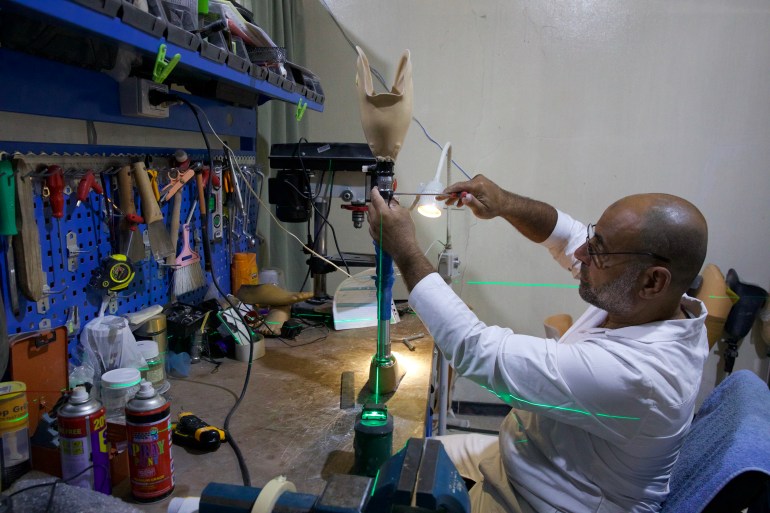
Standing tall again
Rima’s reddened eyes reflect a sleepless night of anxiety and anticipation, but her joy is apparent as she puts on her prosthetic leg and tries it out for the first time.
“Travelling back and forth to Azaz wasn’t easy, but we did it for this moment, because she has been eagerly looking forward to standing once again,” said Haj Hussein.
“Her excitement is overwhelming, and she keeps telling me that she will soon stand like everyone else and pursue her dream of becoming a doctor, just as her father wanted.”
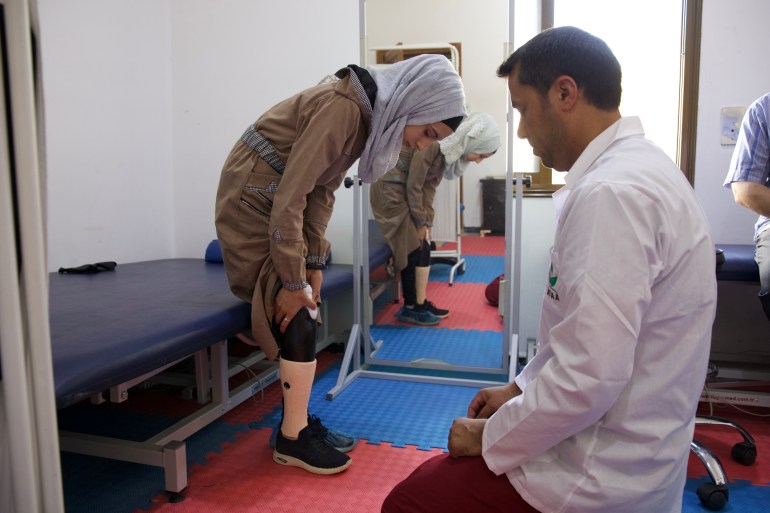
One of the people who worked on Rima’s case is Ahmed Hashem, social projects coordinator at Ataa. While the centre suffers from a lack of funding and scarcity of materials, he said, it was important to them to get as many Syrian amputees as possible fitted with the prosthetics they need.
Hashem told Al Jazeera that the centre has been able to fit prosthetic limbs for 30 earthquake victims who registered through the centre’s link for those who lost their upper or lower limbs.
The fitting process is a painstaking one made trickier by the lack of advanced modelling technology, leaving the team to rely on clinical observation and measurement and making careful moulds by hand.
“The increase in amputations in the region after the earthquake has put immense pressure on the centre, making it challenging to secure prosthetic limbs for all the injured,” said Hashem.
“We hope that with time, we can find what we need to make prosthetics for all the injured and expand our work to include fitting smart and mechanical prosthetics,” Hashem added.
Before the Syria-Turkey earthquakes, the number of Syrian amputees was documented at 86,000 in 2017, according to the World Health Organization, whose report said that the wait for help then was already a long one. In addition to those figures are the Syrians who live with permanent disabilities, who number at least 1.5 million people.
But for one day, there is joy in one household as Rima, beaming, walks out of Ataa centre after arriving in her wheelchair – taking her first steps on her brand new leg, striding forward to her next challenge.
